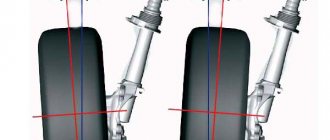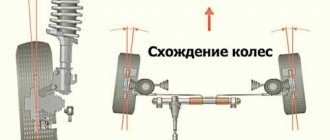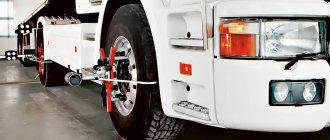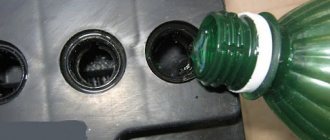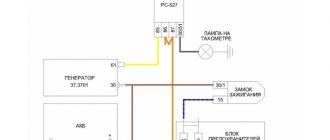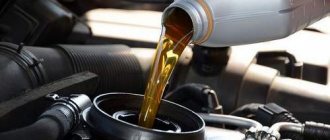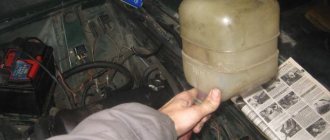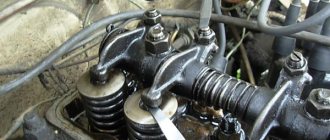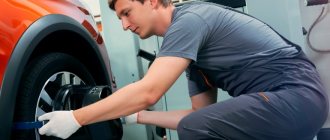Adjusting the wheel alignment angles, or adjusting the wheel alignment, takes about an hour if there are no breakdowns in the suspension. If the vehicle has problems with the adjustment bolts and suspension components, the procedure can take up to two hours.
Wheel alignment is an essential procedure that will help you extend tire life, provide optimal braking, a comfortable ride, and improve safety on the highway. You should have your wheel alignment adjusted every 2 or 3 years or every time you have your vehicle's suspension and steering system serviced.
How long does it take to do a wheel alignment?
Car lovers often think about the proper performance of their vehicle, and this is no coincidence, because this factor is directly related to the service life.
Car owners are often interested in the question: when is it necessary to do a wheel alignment? There is a lot of advice and disagreement here. Let's try to look at this situation in more detail. Most service stations analyze vehicle data with negligence because it makes their job easier. It is often not taken into account that a car in which the trunk is often loaded behaves differently. Here it is necessary to carry out tests both in a light position and with increasing load. Another important indicator of a car’s performance is the level of pressure in the wheels, however, even here, mechanics often leave things to chance.
When you call a service technician, make sure they check your wheels thoroughly and follow all the procedures.
When balancing is necessary
There are several procedures related to car repair and maintenance, when it is necessary to carry out work related to adjusting the position of the wheels relative to the body.
These rules apply to all cars, whether:
Wheel alignment work
Checking the condition of tires and suspension . Before starting work, the technician must make sure that the chassis is in good condition, the tires are worn evenly and not too much, and the pressure level in them is normal. There is no point in adjusting wheel alignment if there are faults, worn tires, etc.
Carrying out measurements . The technology depends on the stand used. Angles can be measured in a pit or on a lift. After measurements are taken, the actual angles are compared with the reference angles for a specific model.
Adjustment . The position of the wheels is adjusted so as to eliminate detected deviations in installation angles. The adjustment can be done manually by a technician. Modern models of stands also allow it to be carried out by rolling (the process is partially automated).
Repeated measurements . It is necessary to make sure that after adjustment the wheels are in the correct position.
Main characteristics
| Make: BMW | Gearbox: automatic / manual |
| Model: X1 | Body: sedan, coupe, station wagon |
| Year of issue: 2009 | Power: petrol/diesel |
| Engine capacity: 1985 cm³ | Drive: rear |
–>
One of the frequent reasons for motorists to contact the workshop is to perform a wheel alignment. The reasons and situations when it is necessary to do a wheel alignment can be varied, but it definitely must be done efficiently, otherwise the driver risks encountering a lot of adverse consequences, including premature tire wear, poor handling, etc. The vast majority of car owners trust this type of work to professionals, but you can try to do it yourself. True, for this you need to know the correct sequence of actions and some important nuances.
Wheel alignment adjustment
Before starting the adjustment process, an experienced technician must check the technical condition of the car, diagnose the chassis and check the tire pressure. Identified malfunctions must be eliminated before the wheel alignment begins, informing the client about them. Of the preparatory operations, the operation of “compensating for wheel rim runout” is considered especially important and mandatory. This operation is carried out in order to eliminate the influence of the geometric shape of the wheel rim. The next thing is to diagnose the geometry of the chassis based on instrument readings. We detect and eliminate deficiencies such as displacement of axles or side members and other faults that can affect the handling and stability of your car, regardless of the wheel alignment adjustment.
Signs of wheel alignment problems
The technical manual for the car model, as a rule, indicates after how many kilometers it is recommended to carry out routine diagnostics of camber and toe indicators.
But in practice, this figure becomes very arbitrary, since the car can be used in different conditions. Therefore , in order to determine the need for diagnostics, you should be guided by the following signs:
- if the wheels are in a straight position, the steering crossbar remains shifted to any side from the horizontal;
- on a straight, level section of the road, if you let go of the steering wheel, the car goes to the side;
- on a straight course the car “yaws” and behaves unstable;
- turning the steering wheel is processed late;
- the steering is too unyielding (“stiff steering wheel”);
- with serviceable brakes, the car skids to the side when the speed drops sharply;
- on long turning radii, the wheels touch the fender liners;
- the steering wheel does not return to its normal position when the car completes a turning maneuver;
- while the car is moving, the tires rustle uncharacteristically;
- car tires wear unevenly (provided that the pressure in them is maintained within the required limits).
A clear example of how alignment affects the position of the wheels on a car
Let's look at another interesting example, which concerns the care of car tires. A fairly detailed foreign video will help us study the material. Don't worry, we'll give you a translation of the main points:
The 1st minute of the video shows and describes how wheel camber affects the handling of a car. In this case, negative. Typically used by sports car manufacturers, it makes it easier for them to turn into corners at high speeds by actively resisting tire deformation and increasing friction.
More “civilian” camber options are more concerned about the safety of tires and rolling.
The 2nd minute of the video visualizes the so-called castor - the angle of longitudinal inclination of the steering axis of the car wheel. In other words, this is wheel runout, exactly the same as on bicycles or motorcycles. They simply see this better using the example of a fork.
The castor setting is a sports setting and is not used on regular cars.
The 3rd minute of the video shows the wheel alignment. The smaller the toe-in, the less tire wear. However, when driving, the driver involuntarily makes small movements with the steering wheel. These mini-steers should not affect straight-line movement, which the toe-in handles perfectly.
How long does it take to get a wheel alignment?
It takes an average of half an hour to adjust the wheel alignment. The duration can fluctuate up or down, it all depends on the car itself - what condition it is in, and on the car service - who works in it and on what equipment.
On average, the wheel alignment procedure takes at least 30 minutes, assuming that everything turns easily and is not rusty. But is it also possible to take into account a car from the street and consider its condition as average, then in the area of an hour this will be considered the norm.
When I was studying, we were told in lectures about wheel alignment, today they increasingly say: wheel alignment.
VIDEO ON THE TOPIC: Wheel alignment. What is useful to know?
Dear readers! Our articles talk about typical ways to resolve legal issues, but each case is unique.
If you want to find out how to solve your particular problem, please use the online consultant form on the right or call the numbers provided on the website. It's fast and free!
- How long does a wheel alignment take?
- How long does it take to do a wheel alignment?
- How long does it take to get a wheel alignment done at a car service center?
- How long does it take to do a wheel alignment?
- How often does a wheel alignment need to be adjusted?
- Wheel alignment - how often to do it?
How long does a wheel alignment take?
Please indicate your contacts and we will contact you within a few minutes. Wheel alignment and camber in relation to each other are two different suspension parameters that have the same adjustment goal, which is to improve the driving performance of the car.
Why do you need to do geometry when replacing components and parts of the chassis?
The position of the car wheels depends on the positioning of the chassis parts. For example, when replacing a ball joint, rod, rack, or zero tip, the gap between the parts changes. This leads to the appearance of an angle of inclination of the tires relative to the horizontal plane. The previous settings also fail when changing the shock absorbing spring or tires, since the installation angle depends on the ground clearance.
Replacing chassis components may result in the steering wheel being in the wrong position. In this case, driving the car is prohibited, since its body may spontaneously move to the side while driving. Any malfunction requires correction, and an experienced driver determines the need to adjust the wheel alignment after manipulating the chassis by the behavior of the car on the road.
Deciding on the wording
Wheel camber indicator
The camber angle is the angle formed by the rotating plane of the wheel and its conventional vertical.
The value of this indicator determines what position the car’s wheels will be in when cornering, and, accordingly, how clearly the car will take the turn.
What is a car loan
The concept of a car loan is practically no different from a regular loan. This is money that a bank can provide for the purchase of a used or new car. In order to have a guarantee of payment of the amount on time, a car is taken as collateral, which implies the impossibility of reselling it. You should not rely on the bank's work without receiving benefits for yourself. Usually the payment is interest and commissions, which constitute profit for the credit institution, so if an advertisement talks about installment plans without extra expenses, you should not hope that this will bypass you.
When receiving a loan, the bank will take a small percentage for its work, so in order to avoid receiving a fine, you must make payments on time.
Types of equipment
To adjust the wheel alignment, you should contact a car service center. Craftsmen have special stands at their disposal that allow them to detect gaps invisible to the eye and perform the necessary adjustments.
Wheel alignment adjustment stands are special machines whose main task is to determine the angle of inclination of car wheels and set it if they are in an incorrect position.
Based on the principle of operation, the devices are divided into several types:
- Optical. The very first units for adjusting RS. The research process on them takes a lot of time, and errors are possible.
- Laser. A variety of optical equipment. Angles are measured using a laser beam.
- Computer. Modern high-precision equipment, in which electronic computing devices are engaged in collecting and processing information. 3D stands create a three-dimensional projection of the vehicle. They help perform diagnostic and adjustment work as accurately and quickly as possible.
Optical stand
An optical bench uses light beams for measurements. They come from special tubes placed on the wheel rims. During measurements, a light beam is projected onto a screen with linear and angular scales. Experts compare the readings taken with the standards.
Such equipment is considered obsolete. Among its advantages are durability and low maintenance. However, it is not found in modern service stations.
Laser equipment
According to the principle of operation, such stands are similar to optical units. However, the source of measurement is a directed laser beam.
The operation of the system is organized simply:
- Laser emitters are installed on the car at the same distance from each other and in relation to the measurement scales;
- mirrors are mounted on the tires (parallel to the plane of rotation), opposite which measuring scales are installed;
- laser beams are calibrated so that their line of passage runs parallel to the wheel plane;
- the beam reflected from the mirrors must return to the starting point (this is the zero scale division);
- if there are deviations, it will fall higher or lower, which will show the magnitude of the error.
The stands are distinguished by accurate measurements and allow you to simultaneously calibrate all the wheels of the car. However, one study takes about an hour, since the adjustment of mirrors and laser generators is carried out manually. This requires skill and experience of specialists. When work is performed by an incompetent mechanic, errors may occur.
Making adjustments yourself
Preparing for measurements and subsequent adjustments
To carry out independent work on adjusting the angles of the vehicle wheels, you will need the most flat horizontal platform equipped with an inspection hole. You also need to prepare the following tools and auxiliary equipment:
- driver's tool kit;
- a plumb cord or building level, a piece of chalk;
- folding measuring ruler or tape measure;
- a skein of strong rope or flexible wire;
- two timbers with a flat surface, 60 cm long;
- two sliding supports for car wheels (can be made from 4 metal plates, lubricating each pair of plates with grease to ensure the best sliding).
